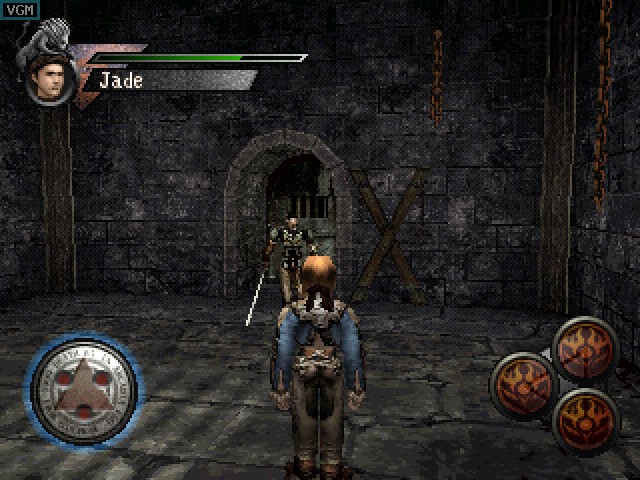
The Deception series began three years ago with Tecmo’s Deception, an odd blend of strategy, role-playing and monster raising. Deception II followed one year later, refining the design a bit. Before its release, it was widely thought that Deception III: Dark Delusion would hone the concept to perfection. Alas, the truth is somewhat different.
The game casts the player in the role of Reina, a young girl who has witnessed the execution of her stepmother and brother at the hands of a ruthless king. Her skill at setting and using traps enables her to escape the same fate. On her journey, she faces many adversaries who wish to end her life as well as many who try to help her understand her trap skills.
Deception III‘s story-line is a convoluted mess that involves Reina, her former captors, and some allies that attempt to help her. Basically everything is an excuse to get victims in range of Reina’s traps. A long-winded cinema will set the stage for each mission. In the cinema, you’ll find out who’s after Reina. They’ll spend a lot of time talking in poorly translated English subtitles and then eventually enter whatever room Reina is in. The cinema ends with a brief on-screen synopsis of what just transpired. (Which makes the cinemas rather redundant.) The player takes control of Reina, who must avoid being killed by her assailants while trying to ensnare them in her traps.
That’s what makes this game different from most others. Reina fights her opponents through the use of strategically placed traps in each room. There are floor traps, ceiling traps and wall traps that the player can position via a 3D grid layout of the room. Some rooms have traps already in place, such as falling chandeliers or spikes that spring from a wall. Many levels feature interconnecting rooms that Reina can run between. Each room can be set up with a fresh supply of traps. Once used, a trap requires a small amount of time to recharge before it can be used again. Reina’s traps can also be moved at any time, as long as they are not recharging.
The traps are unique in their sheer brutality. Floor traps can take the form of a simple bear trap or a blast zone, which is basically an explosive device that you trigger via the PlayStation’s controller. Ceiling traps include swinging pendulums and falling rocks that can be dropped on an opponent’s head. Wall traps include spikes or moving walls that can push enemies into the range of another trap. The game encourages the use of combos to injure enemies. For example, a wall trap could throw an enemy into a bear trap which will hold him or her long enough to bring a pendulum’s blade down for the final blow. Once the opponents are killed, you can view a “death file” which will show you how they died. You will also receive special power-ups, like new traps or items that affect the way other traps work. Then it’s on to the next cinema and the whole chain of events starts all over again.
The game’s ingenuity is soon overshadowed by the fact that this endless series of missions doesn’t really tell a great story. Since Deception III tries to pass itself off as a sort of strategy RPG, a story-line is somewhat important to getting the player interested in the on-screen goings-on. After about six or seven missions, the game becomes horribly dull. Boring, in fact. That’s not to say it starts off that way. In fact, the tutorial that explains the trap-setting process is very entertaining. Unfortunately, the game just doesn’t have much going for it in the longevity department.
Deception III‘s graphics may look good in screenshots, but in actuality they’re marred by a poor frame rate and a lot of polygon problems. While one wouldn’t be prompted to call the game ugly, it certainly does not rank with the PlayStation’s best looking games. It’s a shame because the game does have a very unique look to it.
In-game sounds are virtually non-existent. Traps make noises when sprung, your heels make noise when you walk around, and there’s an overly dramatic soundtrack. Overall, that about covers the gamut of Deception III‘s sound effects. They’re ably crafted, but there’s simply not much to listen to. The game engine rendered cinemas feature a lot of dialogue, but they’re subtitled with no voice-overs. The pre-rendered cinemas, which feature critical story-line points, are subtitled and feature Japanese voice-overs.
The game’s control scheme works, but one gets the feeling that it could have been made a more pleasing experience. Running from place to place is no problem, but trying to keep an eye on not only Reina’s position, but the position of enemies and traps can be a little daunting, especially when facing enemies with higher intelligence. Early opponents will blindly walk into traps, but later foes will not only avoid them, they’ll do it quickly. You can press a button that will make you turn and face an opponent and that helps things a little bit. You can pause the game and look at a map of everyone’s position, but doing so interrupts the flow of the game and is more intrusive than intuitive.
Deception III is a game that dares to be different. I give it credit in that regard. However, the overall concept just doesn’t work as a long, involved game. The variety of different traps available does little to offset the fact that setting traps and getting people to trigger them gets old quickly. If this trap-setting idea were to be used along with some other innovative, mission-oriented elements, a winner of a game might just spring to life. Unfortunately, Deception III‘s concept wears thin after only a few plays. It might be good for a weekend rental at best, but it’s definitely not worth shelling out hard cash to buy.
4 out of 10.

